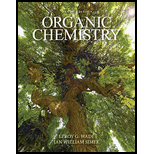
Concept explainers
(a)
Interpretation:
The resonance forms of pentadienyl radical to show the three carbon atoms that bear unpaired electron are to be stated.
Concept introduction:
The delocalization of lone pair or free electrons from one place to another is known as resonance. The stability of compound depends upon the number of resonating structures. More the resonating structures of compound more will its stability.
(b)
Interpretation:
The number of molecular orbitals in the molecular orbital picture of pentadienyl radical is to be stated.
Concept introduction:
Molecular orbital diagrams are used for determining the bonding in molecules using linear combination of atomic orbitals. The number of molecular orbitals formed is equal to the number of atomic orbitals that combine with each other.
(c)
Interpretation:
The number of nodes presents in lower-energy molecular orbital and highest-energy molecular orbital of pentadienyl radical is to be predicted.
Concept introduction:
Molecular orbital diagrams are used for determining the bonding in molecules using linear combination of atomic orbitals. The number of molecular orbitals formed is equal to the number of atomic orbitals that combine with each other.
(d)
Interpretation:
The molecular orbitals of pentadienyl system in order of increasing energy are to be drawn.
Concept introduction:
Molecular orbital diagrams are used for determining the bonding in molecules using linear combination of atomic orbitals. The number of molecular orbitals formed is equal to the number of atomic orbitals that combine with each other.
(e)
Interpretation:
The number of electrons present in each molecular orbital of pentadienyl radical is to be stated.
Concept introduction:
Molecular orbital diagrams are used for determining the bonding in molecules using linear combination of atomic orbitals. The number of molecular orbitals formed is equal to the number of atomic orbitals that combine with each other.
(f)
Interpretation:
An explanation to show that molecular orbital picture agrees with the resonance picture that shows the delocalization of unpaired electron on the three carbon atoms is to be stated.
Concept introduction:
Molecular orbital diagrams are used for determining the bonding in molecules using linear combination of atomic orbitals. The number of molecular orbitals formed is equal to the number of atomic orbitals that combine with each other.
(g)
Interpretation:
The carbon atoms that share the positive charge and the picture agree with the resonance structure or not are to be stated.
Concept introduction:
Molecular orbital diagrams are used for determining the bonding in molecules using linear combination of atomic orbitals. The number of molecular orbitals formed is equal to the number of atomic orbitals that combine with each other.
(h)
Interpretation:
The carbon atoms that share the positive charge and the picture agree with the resonance structure or not are to be stated.
Concept introduction:
Molecular orbital diagrams are used for determining the bonding in molecules using linear combination of atomic orbitals. The number of molecular orbitals formed is equal to the number of atomic orbitals that combine with each other.
Want to see the full answer?
Check out a sample textbook solution
Chapter 15 Solutions
Organic Chemistry Plus Mastering Chemistry with Pearson eText -- Access Card Package (9th Edition) (New in Organic Chemistry)
- Draw the major product formed via an E1 pathway.arrow_forwardPart 9 of 9 Consider the products for the reaction. Identify the major and minor products. HO Cl The E stereoisomer is the major product and the Z stereoisomer is the minor product ▼ S major product minor productarrow_forwardConsider the reactants below. Answer the following questions about the reaction mechanism and products. HO Clarrow_forward
- julietteyep@gmail.com X YSCU Grades for Juliette L Turner: Orc X 199 A ALEKS - Juliette Turner - Modul X A ALEKS - Juliette Turner - Modul x G butane newman projection - Gox + www-awa.aleks.com/alekscgi/x/Isl.exe/10_u-IgNslkr7j8P3jH-IBxzaplnN4HsoQggFsejpgqKoyrQrB2dKVAN-BcZvcye0LYa6eXZ8d4vVr8Nc1GZqko5mtw-d1MkNcNzzwZsLf2Tu9_V817y?10Bw7QYjlb il Scribbr citation APA SCU email Student Portal | Main Ryker-Learning WCU-PHARM D MySCU YSCU Canvas- SCU Module 4: Homework (Ch 9-10) Question 28 of 30 (1 point) | Question Attempt: 1 of Unlimited H₂SO heat OH The mechanism of this reaction involves two carbocation intermediates, A and B. Part 1 of 2 KHSO 4 rearrangement A heat B H₂O 2 OH Draw the structure of A. Check Search #t m Save For Later Juliet Submit Assignm 2025 McGraw Hill LLC. All Rights Reserved. Terms of Use | Privacy Center | Accessarrow_forwardThe electrons flow from the electron-rich atoms of the nucleophile to the electrons poor atoms of the alkyl halide. Identify the electron rich in the nucleophile. Enter the element symbol only, do not include any changes.arrow_forwardHello, I am doing a court case analysis in my Analytical Chemistry course. The case is about a dog napping and my role is prosecution of the defendant. I am tasked in the Area of Expertise in Neutron Activation and Isotopic Analysis. Attached is the following case study reading of my area of expertise! The landscaping stone was not particularly distinctive in its decoration but matched both the color and pattern of the Fluential’s landscaping stone as well as the stone in the back of the recovered vehicle. Further analysis of the stone was done using a technique called instrumental neutron activation analysis. (Proceed to Neutron Activation data) Photo Notes: Landscaping stone recovered in vehicle. Stone at Fluential’s home is similar inappearance. Finally, the white paint on the brick was analyzed using stable isotope analysis. The brick recovered at the scene had smeared white paint on it. A couple of pieces of brick in the back of the car had white paint on them. They…arrow_forward
- What is the product of the reaction? F3C. CF3 OMe NaOH / H₂Oarrow_forwardWhat would you expect to be the major product obtained from the following reaction? Please explain what is happening here. Provide a detailed explanation and a drawing showing how the reaction occurs. The correct answer to this question is V.arrow_forwardPlease answer the question for the reactions, thank youarrow_forward
 Organic Chemistry: A Guided InquiryChemistryISBN:9780618974122Author:Andrei StraumanisPublisher:Cengage Learning
Organic Chemistry: A Guided InquiryChemistryISBN:9780618974122Author:Andrei StraumanisPublisher:Cengage Learning

